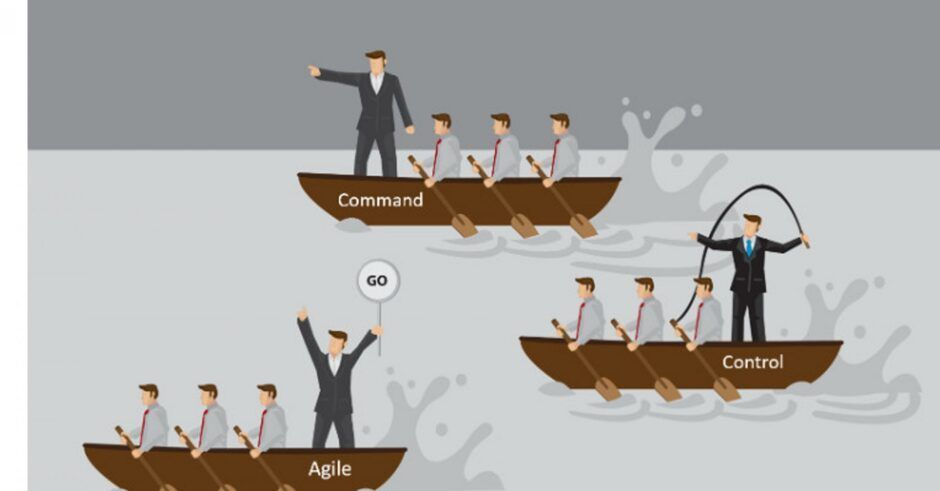The existence of contrasting ways of managing people – agile and traditional top-down leadership – creates divergent experiences for employees, also sending mixed messages about what the organisation values. The case for all leaders becoming more agile in their thinking and actions ahead of changing structure in any part of an organisation, when introducing agile ways of working.
1. The difference between agile and traditional leadership
Beware some generalisations follow … acknowledging that of course there are and have always been, leaders and managers who enable their teams to use and follow their own initiative and be innovative, before agile became de jour. In response to the velocity of technology advancement ‘scrum’ emerged in the mid-1990s followed by ‘adaptive system development’, in the lead up to the ‘agile manifesto’ developed in 2001. All movements to hardwire team adaptiveness and speed of response to change, no longer leaving it to chance for software developers.
The cornerstones of agile leadership are well documented; enabling team autonomy and self-management through transferring greater responsibility, reducing time spent on planning and meetings and documentation, establishing trust-based relationships that reward innovation, creativity, experimentation, collaboration and learning. Agile leaders actively listening and learning from their employees, helping leaders to rethink and reframe their business in the age of accelerated advancements in technology and science, and increasing globalisation.
In direct contrast, the hallmarks of traditional hierarchical leadership lean towards more ‘command’ and/or ‘control’ behaviours of providing directives to employees often including the ‘how to’ of activities and monitoring progress. Valuing their employees achieving predefined goals over learning and innovation, old-school leaders usually rely on their own knowledge and experience ahead of the collective wisdom of their teams.
Organisations introducing agile ways of working that exist in only a few areas of their business – phasing it’s implementation or scaling agile to their business needs – can inadvertently create two irreconcilable employee experiences and subcultures.
2. Dangers of contrasting employee experiences and subcultures
Obviously, the difference between agile and traditional leadership creates vastly different experiences for employees. Agile teams liberated from numerous meetings and oversight spend far more time collaborating and engaging with team colleagues with diverse skills, opening up more development and career opportunities. Increased productivity also increasing job satisfaction.
Embracing Agile includes research by Scrum Alliance where 70% of agile practitioners reported tension existing between their teams and the rest of the organisation, “little wonder, agile teams are following different roadmaps and working at different speeds.”
Working in an agile way may not be for everyone or appropriate for every team, in the cartoon at the top of this article which boat would you rather be crewing in?
For self-managed agile teams positioned underneath traditional leaders and structures, their experience can be an unhappy one. Leaders slowing down progress through requiring additional meetings and traditional reporting on top of agile ways of sharing and tracking progress. Leaders also getting involved at a detailed level not trusting the collective capability of the team; providing directives, making decisions, setting priorities and deadlines at odds with those of the team’s. Often punishing rather than rewarding the team for experimentation and testing that inevitably results in some failures.
Organisations will always have a number of subcultures associated with geographic locations, diversity of teams and employees. A key responsibility of leaders is to connect all subcultures through their behaviours that demonstrate shared values espoused by the organisation, and rewarding employees whose actions reflect those values.
The dissimilar relationships agile and hierarchical leaders have with their teams and the contradictory messages they send about what employee behaviours they value, separate rather than connect subcultures. Entrenching silos and the resultant negative impacts on all areas of the organisation’s performance.
3. Change leadership and culture before structure
There’s a view that culture follows structure, hence it also follows that two divergent structures i.e. a bimodal organisation, will also create problems associated with two divergent subcultures.
In 5 Ways to Help Employees Keep Up with Digital Transformation #1 in the list is commitment to new ways of working must start at the top. L’Oreal for example kicked off implementing agile ways of working with their top 1,000 executives participating in a leadership development program. Moving them to a more an agile mindset and acquiring the knowledge and skills to lead a digitally capable and agile organisation.
Embracing Agile highlights that GE also piloted agile practices with their leadership team. The CEO of Systematic on realising his leadership group were being left behind and becoming a hindrance, similarly started running them as an agile team.
Designing a more adaptive culture before changing structure, by equipping all leaders to have greater agility in thinking and actions prior to restructuring any areas to a new agile way of working, reaps benefits for the whole organisation.


